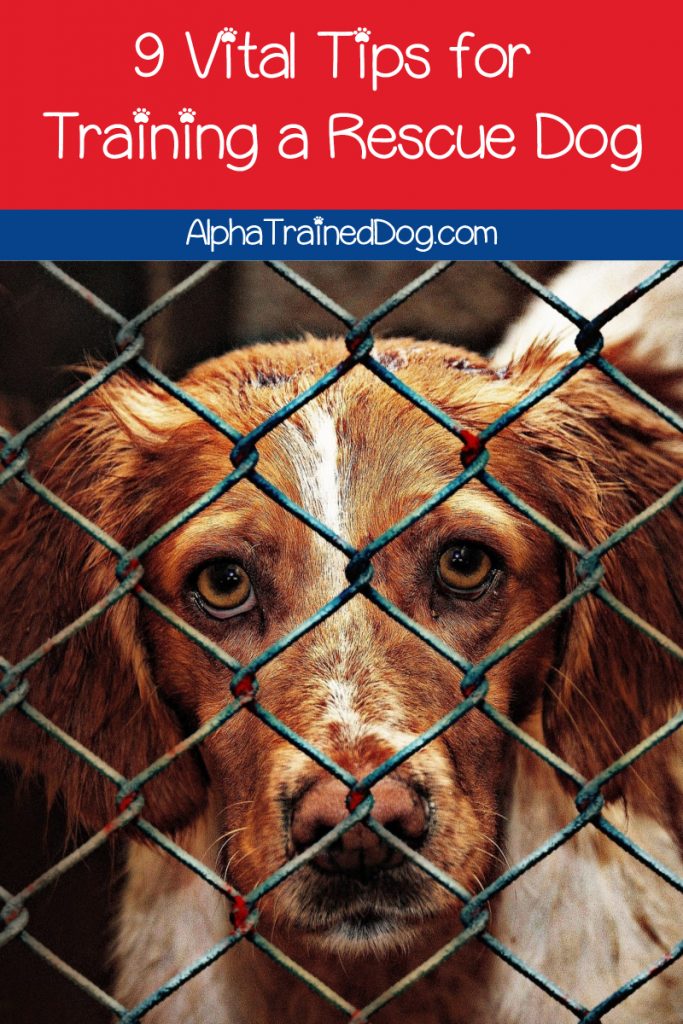Do you need some tips on how to train your rescue dog?
Opening your house and your heart for a dog in need is great, but it’s natural if you’re a little overwhelmed by the experience.
Fortunately, I’ve got your back with these 9 amazing training tips to help you bond with your rescue dog.
Keep reading to learn more!

9 Tips for Training a Rescue Dog
Let me start by telling you that it’s never too late to start training a dog.
It doesn’t matter if your rescue dog has any prior training experience. All you need is patience, treats, and a lot of positive reinforcement to make it work.
Not all rescue dogs would have been abused or neglected, but some will have emotional scars.
So, you should always tread carefully until you can determine your pooch’s triggers.
#1 Make No Assumptions
Usually, puppies are a clean slate, and they’re ready to absorb everything you teach them.
However, rescue dogs already have some good and bad habits formed. And here’s where it gets tricky.
Often dogs get abandoned in shelters or kicked out of the house because they bark, pee in the house, or make a mess when left alone.
When you rescue a dog, you can’t know how socialized they are or their level of training.
If you set your expectations too high and your rescue dog fails to meet them, you’ll be disappointed.
That will reflect on how you train your dog. So, assume that your rescue dog doesn’t have any training and start from the very beginning.
#2 Expect an Adjustment Period
All puppies are afraid and scared when you bring them home for the first time.
However, puppies usually adjust quickly to their new surroundings because they’re young, curious, and open to new experiences. The same isn’t true for a rescue dog.
We can’t imagine the stress and anxiety that a dog feels when they get abandoned in a shelter.
Moreover, some dogs come from abusive homes, and the trauma they’ve endured makes them suspicious of new people.
Naturally, these dogs will need some time before they warm up to you and your house.
It might be a couple of weeks or a couple of months. In depends on your rescue dog’s character and how traumatic their life has been up to now.
#3 Establish a Daily Routine
When dogs live on the street, they don’t know what’s going to happen to them next.
Life becomes unpredictable and full of scary events that keep your pooch on their toes all day long.
While being in a shelter or rescue organization is better, being surrounded by dozens of other dogs is very stressful.
That’s why it’s important to establish a daily routine as soon as possible when you’re training a rescue dog.
Dogs love predictability, especially those that have seen some hard times in their short lives.
It will make your pooch less anxious if they know that they’re getting food, attention, and exercise regularly.
So, do your best to be consistent when it comes to feeding and walking your rescue dog. That will speed up the adjustment period.
#4 Set the Rules
You might be tempted to dote on your rescue dog for the first few weeks, and you might be reluctant to correct them when they misbehave. That’s a huge mistake.
One of the essential things when it comes to training a rescue dog is to set your rules from the beginning and stick to them.
Once your rescue dog gets comfortable doing something “bad” it will be twice as hard to stop them.
Your rescue dog won’t understand why it was okay to chew on your shoes yesterday, but not today. So, they will continue to do it.
#5 Start Obedience Training
A lot of owners think that they should wait until their rescue dog has settled in before they engage in training.
However, obedience training is an excellent way to bond with your dog and earn their trust. So, you shouldn’t postpone it.
Use as much positive reinforcement as possible and reward your rescue dog with treats whenever they respond to your commands.
Don’t rush things and take your time to master a command before you move to the next one.
#6 Housetraining and Crate Training Are a Must
Besides obedience training, start housebreaking the moment you bring your dog home.
Waiting a couple of days is all your dog needs to form bad habits and start peeing everywhere in the house.
Housebreaking a rescue dog is the same as housebreaking a puppy.
You bring them to your designated potty spot as much as possible and reward them with treats.
The difference is that rescue dogs might get it quicker than puppies because of prior experience.
Crate training will also be beneficial for training a rescue dog.
A crate provides a safe spot where your rescue dog can retreat when they get overwhelmed. It also helps you teach your dog to hold their bladder.
Unfortunately, some dogs might have had negative experiences with crates if their previous owners have used them for punishment.
So, start it as slow as possible and make it as positive as you can. Turn the crate into a comfy place and put inside your dog’s favorite toys.
Don’t shut your dog inside before you’re confident that they can handle it.
#7 Don’t Dote Too Much on Your Dog
It’s not a good idea to make your rescue dog too dependent on your presence.
You’re not going to be around all day long to keep them company. As such, your rescue dog should know how to entertain themselves.
Moreover, rescue dogs might develop separation anxiety if they get too attached to you.
Separation anxiety can lead to destructive behavior when you’re gone, and a dog that whines and cries when you’re about to leave the house.
Don’t get me wrong. There’s nothing wrong with doting on your rescue dog.
However, you have to find the balance so that your dog can deal when you’re not around to offer comfort.
#8 Work on Your Dog’s Triggers
Rescue dogs might be uncomfortable around certain people, smells, or sounds.
It might be due to a lack of socialization or a traumatic experience.
In either case, you have to work out your dog’s trigger so that your pooch doesn’t live in constant fear and anxiety.
You can try to avoid some triggers, but that’s not always possible.
So, your best option would be to desensitize your dog to what’s making them afraid or apprehensive.
Expose your rescue dog to the trigger in a controlled situation and reward them as much as possible when they remain calm.
If your dog’s anxiety levels are too high, take a step back and evaluate.
You might also consider dog training classes so that your pooch can learn manners for other dogs.
#9 Be Consistent
My last tip on training a rescue dog is to be consistent and involve the whole family in the training of your rescue dog.
It’s no good if you’re enforcing one set of rules, and your family members do the opposite.
So, you should explain to all the members of the family how they should act around the dog and what’s allowed and what’s not.
Training a rescue dog will have its ups and downs.
Don’t be afraid to seek help or enroll in obedience classes when you feel that you’re out of your depth.
Be patient and don’t misuse the fragile trust your rescue dog has in you, and everything will turn out fine.



What a great post and tips for helping settle in a rescue dog. It can be difficult but so rewarding taking on a rescue dog.
This is a fascinating and informative article! I love it. It’s so important to focus on dog’s triggers. We often reflect on triggers for humans, but we forget the value of knowing the ones that trigger pets. Thanks for this wonderful post!